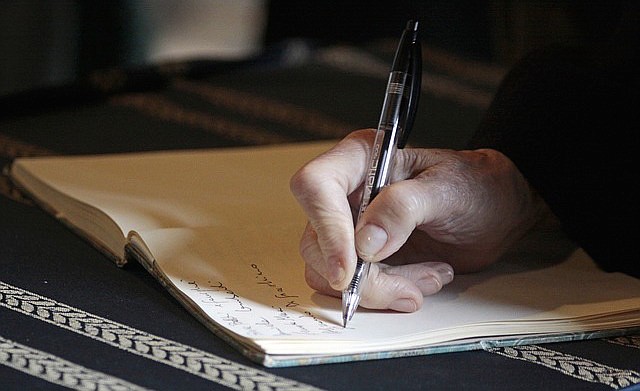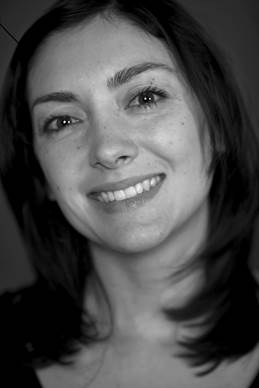On an uphill walk to a 9 a.m. appointment at the new University of Tennessee at Chattanooga library on Tuesday morning, I had to stop to find a water cooler. Nervousness had made my mouth dry. As I stood at the fountain, I tried to tell myself it was the winter wind, or the Benadryl antihistamine I'd taken the night before, but in retrospect it was clearly nerves.
Here's the curious part: Last month I was standing face to face with the Leader of the Free World and I didn't blink, and yet the prospect of talking to a 33-year-old junior member of the UTC English Department faculty had, for some reason, rendered me cotton-mouthed. Embarrassingly, I was starstruck and a bit unsure of myself: As if my assignment were to stare into the sun for an hour and report back the truth about brilliance.
Kerry Howley's talent apparently has that effect on other writers. Reviews of her new book "Thrown" read as if the book critics are all auditioning for cover blurbs. Time magazine's Lev Grossman called "Thrown" "the most bizarre and fascinating book I've read this year." Publisher's Weekly said Howley's first book "threatens to remap the entire genre of nonfiction."
Heady stuff. But when you can write impossibly lyrical sentences about a topic as gritty as cage fighting, that's what you get.
Why is she here in Chattanooga, then, this great young writer and thinker? Apparently, because Chattanooga Googles well.
"I've had a new book, a new baby and new job in the space of a year," Howley told me, noting that she and her husband, William Wilkinson, researched the Scenic City online and came to the quick conclusion, "Oh my God, it's gorgeous."
Howley's "Thrown" (Sarabande Books, $16) is an examination of America's mixed-martial arts subculture through the eyes of a fictional narrator named Kit, a hyper-analytical graduate student loosely based on the author. Kit has a habit of pontificating about philosophers to explain the deeper meaning of cage fighting to the fighters themselves, to which one sniffs, "You're insane."
While herself a graduate student at the prestigious Iowa Writers Conference at the University of Iowa, Howley spent three years in the company of these MMA fighters as they tried to climb the ladder in a sport that many Americans still see as a spectacle of savagery.
While her narrator is fictitious, Howley's descriptions of the fighters and their fights are meticulously documented. She used video, audiotapes and mountains of notes as the raw materials of her book. "Describing bodies moving through space is a real challenge," she explains.
After sitting down to talk with her, I was relieved to find out that she is not onlyintellectually gifted -- which is clear in "Thrown" from the get-go -- but also completely charming. She and her husband, Will, who writes for The Economist, moved to Chattanooga last year. They have an infant son, Felix.
"It's been a good year," she says, careful not to sound immodest.
"Thrown," has raised Howley's profile from a well-respected reporter and essayist -- whose work has appeared in Harper's, The Wall Street Journal and Slate -- to an emerging celebrity author. In the digital age, it is possible for a well-reviewed author to sit and read reviews of her work for hours. Yet the author says she resists indulging herself. "It makes me deeply uncomfortable to read about my own writing," says Howley, who describes "Thrown" as a "small book."
But much as 20th-century literary lions such as Norman Mailer and George Plimpton elevated boxing with their insightful prose, Howley has caused serious people to take a look at mixed-martial arts fighting, which many of us in the suburbs still think of as that unpleasantness on pay-per-view television.
"People were very skeptical that I could make a work of art from something so brutal," she said. "But people had no problem conceding that someone could turn boxing into poetry."
"Thrown" follows the lives of two fighters.
Sean, in his early 30s, is a journeyman whose virtues as a fighter are limited to absorbing punishment in the octagon and taking any fight he is offered.
Erik, on the other hand, is a single-minded 20-something who has great natural fighting skills that ultimately propel him to the top echelons of the sport. Erik also has the ability to shed copious amounts of weight to fight in the 155-pound class, and some of the best passages in the book are about his self-starvation.
Howley says Erik taught her about "purity of focus." Meanwhile, from Sean she learned about bravery and how to be comfortable in one's own skin.
It becomes clear from reading Howley's "Thrown" that MMA fights are far more complex than the barroom brawls they appear to be. In fact, there is deep tactical strategy and years of intense training involved in mastering MMA fighting, she says.
To better understand the sport, Howley took instruction in Brazilian jujitsu -- the black art of MMA -- but she soon came to the conclusion that she would never develop any mastery. Her muscles apparently didn't have the vocabulary to answer the questions being asked of them.
Her mind has no such limitations.
Welcome to Chattanooga, Kerry Howley. We're lucky that you're here.
Since she is unlikely to read this, someone please tell her I said so.
Contact Mark Kennedy at mkennedy@timesfreepress.com or 423-757-6645. Follow him on Twitter @TFPCOLUMNIST. Subscribe to his Facebook updates at www.facebook.com/mkennedycolumnist.


